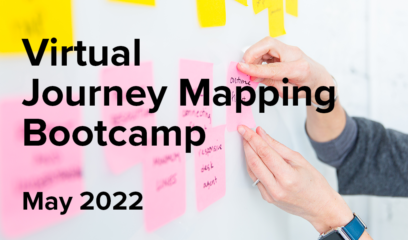It’s the beginning of a new year, which is always the perfect opportunity to reflect on the past and make grand plans for the future. As part of that effort, I recently took a look back at our most popular posts of 2017—and I wanted to share them with you here. I hope they inspire your work for 2018 and beyond!
So without further ado, let’s begin the countdown…
Number 10: Hypothesis Journey Maps: Necessary AND Dangerous
https://www.kerrybodine.com/hypothesis-journey-maps-necessary-and-dangerous/
Hypothesis journey mapping is necessary because it ensures you’re not reinventing the wheel with your journey mapping efforts, but rather building on what your organization already knows about the customer experience. However, in the wrong hands, hypothesis maps are extremely dangerous because they’re full of assumptions that are incomplete at best—and at worst, downright wrong. Read this post to understand how you should incorporate internal hypothesis mapping exercises into your larger journey mapping initiatives.
Number 9: How “T-Rex Arms” Help Uncover Rich Customer Insights
https://www.kerrybodine.com/how-t-rex-arms-help-uncover-rich-customer-insights/
This is one of my favorite posts from my partner in crime, Amelia Sizemore. In it, she describes how a simple thought experiment—yes, imagining herself as a T-Rex—helps her facilitate amazing workshops with our clients and their customers. Read this post to up your own workshop facilitation game. (T-Rex suit not required, though certainly encouraged.)
Number 8: Customer Experience & Service Design: Let’s Be BFFs
https://www.kerrybodine.com/customer-experience-service-design-lets-be-bffs/
For the better part of a decade, I’ve had courtside seats to the evolution of two interrelated disciplines: customer experience and service design. Read this post to understand these disciplines from my vantage point as a both a designer and industry analyst—and the potential for these fields to complement, learn, and benefit from each other. (This post originally appeared in my regular column in Touchpoint Journal, published by the Service Design Network.)
Number 7: How To Choose A Persona For Your Journey Map
https://www.kerrybodine.com/how-to-choose-a-persona-for-your-journey-map/
Every journey map needs an associated persona. Why? Quite simply, different customers have different needs and expectations of your organization. If you haven’t defined who is interacting with your organization, you can’t judge whether or not their experience is good or bad. Read this post to learn how to select (or create) personas for your journey mapping efforts.
Number 6: 10 Steps To Mapping Your Current Customer Journey
https://www.kerrybodine.com/10-steps-to-mapping-your-current-customer-journey/
Of the four types of customer journey maps (see post #1 below), the current-state map is the most ubiquitous. That’s not surprising given how many organizations are trying to understand their customers’ current pain points and improve the customer experience. Wondering how you can get started mapping your own organization’s current-state journey map? Read this post and follow our 10 steps. (And be on the lookout for our updated and simplified steps, coming soon!)
Number 5: Why You Need To Measure Journeys—Not Just Touchpoints
https://www.kerrybodine.com/why-you-need-to-measure-journeys-not-just-touchpoints/
It’s taken some time for organizations to evolve from simply creating journey maps to actively using the journey as a framework for how they do business. Journey analytics is one step in the right direction. What is journey analytics? It’s the measurement and analysis of key customer journeys—not just individual touchpoints. The data I cite in this post will help you make the case for realigning your organization’s measurement strategy around journeys.
Number 4: Why Journey Maps?
https://www.kerrybodine.com/why-journey-maps/
Journey maps have become one of the most popular tools for understanding and improving customer experiences. But why are journey maps so popular? And why should you invest in developing them? This post outlines the reasons that the underlying framework of the journey is mission critical for your organization.
Number 3: The 9 Stages Of The Archetypal Customer Journey
https://www.kerrybodine.com/the-9-stages-of-the-customer-journey/
Every single customer interaction fits neatly into one of nine stages, which collectively make up what we here at Kerry Bodine & Co. call the Archetypal Customer Journey. This post will help you understand these stages—and think about which ones you want to focus on for your own journey mapping initiatives.
Number 2: How To Use Our FREE Journey Mapping Template
https://www.kerrybodine.com/how-to-use-our-free-journey-mapping-template/
The number one page on our site gives you access to our free journey mapping template. So it’s no big surprise that our post on how to use said template is also a hot item. Read this post to get the most out of modifying our template for your own journey mapping efforts.
Number 1: The 4 Types of Customer Journey Maps
https://www.kerrybodine.com/the-4-types-of-customer-journey-maps/
I wrote this post back in 2014, yet it remains our top blog post year after year—and one of the top 10 pages on our site overall. Read this post to understand (yup, you guessed it) the 4 types of journey maps and which business objectives each type is best suited to help your organization accomplish.
***
What do you want us to write about in 2018? Let us know below!




